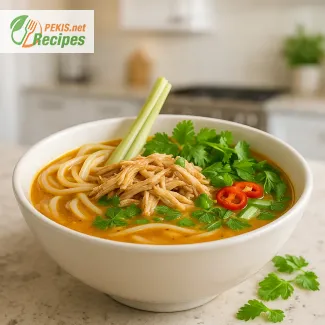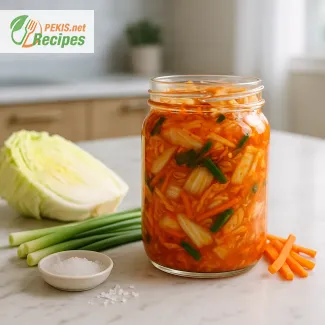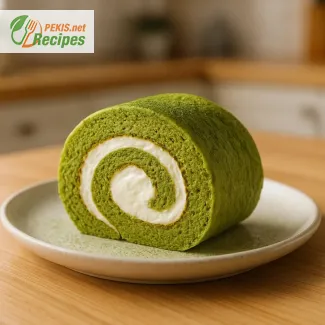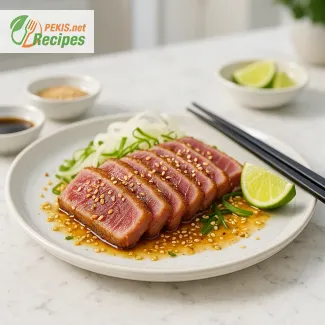Fragrant Khao Poon with lemongrass and meat brings together citrusy brightness, gentle heat and the silky softness of fermented rice noodles in a deeply comforting Lao broth. Each spoonful carries warmth from slow-simmered chicken, the creamy body of coconut milk and the unmistakable aroma of bruised lemongrass. Rooted in traditional Lao cooking, this dish blends fermented tang with herbal freshness, creating a bowl that feels both nostalgic and bold. The texture shifts between tender shredded meat and smooth, broth-soaked noodles, making every bite richly layered and irresistibly satisfying.
Working with lemongrass-based broths for years teaches how much aroma comes from the way the stalks are bruised, not chopped, so the citrus oils release slowly and evenly into the soup. A small detail, but it transforms the depth of flavor in dishes like Khao Poon, giving the broth that warm, rounded scent that lingers in the air long before the first bite.
PEKIS – a professional chef and recipe developer with more than 25 years of experience in cooking and baking, specialized in European and international cuisine.

Aromatic Lemongrass Khao Poon: A Deeply Layered Lao Noodle Stew
A sensory journey into spice, tang, tenderness and slow-fermented warmth
The first spoonful meets the palate with a wave of warm, fragrant broth, carrying the brightness of lemongrass, the richness of slow-simmered meat and the softness of fermented rice noodles that almost melt into the liquid. Steam rises in delicate curls, releasing citrusy notes that mingle with a subtle, earthy depth. Every strand of noodle feels silky, soaking up the broth’s color and aroma, creating a comforting contrast between gentle heat, mellow acidity and aromatic herbs. This bowl reflects the kind of food that carries memories—family kitchens, handwritten recipes and gatherings where time slows down. A dish rooted in community, but intensely personal in the way each bite feels both familiar and new.
Originating in Laos, khao poon has evolved across regions, yet its soul remains anchored in fermented rice noodles and a broth enriched with lemongrass, chili paste and aromatic herbs. The traditional base often includes coconut milk for body and warmth, balancing the tang of fermented noodles. It’s a dish shaped by climate, agriculture and centuries of culinary exchange. Some versions lean toward spicy, others highlight citrus, while many celebrate the subtle sweetness of coconut combined with deeply infused broth. Whether served at festivals, home gatherings or street markets, it’s a meal that brings comfort and unmistakable character.
As the broth simmers, the flavors soften and deepen. Lemongrass releases its citrus oils, meat becomes tender, aromatics blend into a smooth harmony and fermented noodles develop that signature tangy warmth. Herbs added at the end brighten the bowl with freshness, creating a layered profile that feels dynamic but grounded. Each portion becomes a reflection of balance: heat without aggression, acidity without sharpness, creaminess without heaviness.
A similar sense of aromatic comfort appears in dishes built around coconut and gentle rice textures. For those who enjoy exploring complementary flavors, an inviting option is the mildly sweet, fragrant Creamy Coconut Rice Recipe – Perfect Fluffy Side Dish for Every Meal. It offers the same softness and warmth but through a gentler lens, making it a natural pairing when exploring Southeast Asian-inspired meals.
Ingredient interactions that define the dish
The use of lemongrass provides sharp, citrusy clarity that cuts through richer components. Coconut milk smooths the broth, creating a creamy backbone that binds spicy and tangy notes. Fermented rice noodles introduce a unique depth, offering complexity that typical noodles can’t replicate. Herbs like mint or cilantro elevate freshness, while meat—often chicken or pork—adds savory roundness and protein structure. Each component shifts the final profile, contributing aroma, body or acidity.
Why you’ll love this dish
- Bright, citrus-forward aroma from fresh lemongrass
- Comforting depth created by slow-simmered broth
- Soft, silky noodles that soak up every layer of flavor
- Naturally balanced spice that enhances rather than overwhelms
- Versatile base that works beautifully with various proteins
- Aromatic herbs that add freshness and dimension
Creative variations
- Replace meat with shredded tofu or mushroom broth for a plant-forward bowl.
- Add extra lemongrass and lime leaves for a sharper citrus profile.
- Incorporate charred chili paste for deeper smokiness.
- Swap part of the coconut milk for chicken stock to create a lighter broth.
- Garnish with crispy shallots to introduce texture contrast.
Storage and make-ahead notes
Broth can be prepared up to two days in advance and chilled, allowing flavors to intensify naturally. Noodles should be cooked separately and added just before serving to maintain their texture. Herbs and fresh garnishes are best added at the last moment to preserve aroma and color.
Flavor architecture: broth, fermentation and herbal brightness
Understanding how fermented rice noodles interact with broth is key to this dish’s personality. Their gentle acidity lifts the richness of coconut milk, creating a layered structure that feels both comforting and refreshing. Lemongrass provides top-notes that define the bowl’s identity, while protein builds substance and savor. Together these elements create a profile that is warm, aromatic and deeply satisfying, making the stew a true representation of Lao culinary harmony.
- Heat vegetable oil in a large pot over medium heat (180°C / 356°F). Add shallots and garlic, sauté until fragrant and lightly golden.
- Stir in red curry paste and cook for 1–2 minutes until aromatic and well combined with the sautéed mixture.
- Add chicken thighs and coat them thoroughly in the spice mixture. Cook for 3–4 minutes until lightly browned.
- Pour in chicken broth and add bruised lemongrass stalks. Bring to a gentle simmer and cook for 20 minutes until the meat becomes tender.
- Remove the chicken, shred it with forks, then return it to the pot.
- Stir in coconut milk, fish sauce and lime juice. Simmer gently for an additional 10 minutes, allowing the broth to thicken slightly.
- In a separate pot, cook fermented rice noodles according to package instructions. Drain well.
- Place a portion of noodles into serving bowls.
- Ladle the hot broth with shredded chicken over the noodles.
- Garnish with cilantro, mint, spring onions and red chili slices before serving.
FAQ questionWhat makes Khao Poon different from other noodle soups?
Khao Poon stands out because of its fermented rice noodles, lemongrass-forward broth and the balance between creamy coconut and gentle heat. Unlike clear noodle soups, the broth is usually richer, slightly tangy from the fermented elements and deeply infused with aromatic herbs and spices. The noodles absorb the broth, becoming silky and tender, so every bite tastes like a condensed version of the soup rather than just liquid plus noodles. This combination of texture, fermentation and citrusy aroma gives Khao Poon a very specific identity that’s hard to confuse with other soups.
FAQ questionCan Khao Poon be made mild instead of spicy?
Yes. The level of heat in Khao Poon comes mainly from chili paste or curry paste, so it’s easy to adjust. For a mild version, use less curry paste to start, and focus more on the lemongrass, broth and coconut milk to build flavor. The result is still fragrant and layered, just without the strong burn. If cooking for mixed preferences, keep the base mild and serve fresh chili slices or chili oil on the side so each person can dial up the heat in their own bowl.
FAQ questionWhat type of meat works best in Khao Poon?
Khao Poon traditionally works well with chicken thighs, because they become tender and juicy after simmering and add richness to the broth. However, pork, turkey or even shredded beef can also be used if cooked until soft enough to pull apart easily. The key is choosing a cut that can handle slow simmering without drying out. Once shredded, the meat should mix naturally into the broth and cling to the noodles, giving every spoonful a balance of protein, broth and aromatics.
FAQ questionDo the fermented rice noodles taste very sour?
Fermented rice noodles have a gentle tang rather than a sharp sourness. When cooked in the broth, that tang softens and blends into the coconut, lemongrass and spices, adding depth instead of dominating the flavor. The result is a rounded, slightly acidic note that brightens the soup and keeps it from feeling too heavy. If the tang seems too strong, a bit more coconut milk or broth can balance it out, making the flavor smoother and more approachable.
FAQ questionCan Khao Poon be prepared in advance?
Parts of Khao Poon are perfect for make-ahead cooking. The broth with meat, lemongrass and spices can be prepared a day or two in advance and stored in the fridge, which often makes the flavors even more integrated and complex. The fermented rice noodles, however, are best cooked just before serving, as they can become too soft if left in liquid for too long. To serve later, reheat the broth gently, cook the noodles fresh, then combine and garnish with herbs and chili right before bringing the bowls to the table.
FAQ questionWhat side dishes pair well with Khao Poon?
Because Khao Poon is rich, aromatic and slightly tangy, it pairs beautifully with lighter, coconut-based sides or crunchy, fresh elements. A great example is a gently sweet, fragrant rice dish like creamy coconut rice, which echoes the coconut notes in the soup while adding contrast in texture. For instance, the Creamy Coconut Rice Recipe – Perfect Fluffy Side Dish for Every Meal offers soft, fluffy grains that soak up extra broth and balance the spice. Fresh salads with herbs, cucumber and lime also work well, adding crispness and brightness alongside the warm, comforting soup.
The deep aroma of lemongrass, the warmth of slow-simmered chicken and the delicate tang of fermented rice noodles come together in a bowl that feels both comforting and full of character. Each element supports the next, creating a balance of citrus, heat and creaminess that captures the essence of Lao cooking.
Layers of flavor build gradually, from the first rise of steam to the final spoonful of broth. The combination of coconut milk, herbs and tender shredded meat gives the dish a richness that never becomes heavy, while the noodles absorb every nuance, turning texture into part of the experience.
Enjoying Khao Poon means savoring a blend of tradition and depth—bright, fragrant and shaped by ingredients that naturally complement one another. The contrast between silky noodles, aromatic broth and fresh herbs keeps every serving dynamic and satisfying.
Whether prepared for slow evenings or shared gatherings, the dish offers a moment of warmth that lingers. Its balance of freshness, spice and creamy undertones makes it a recipe worth returning to, especially when comfort and bold flavor meet in the same bowl.
Allergens present in the recipe
- Fish sauce – contains fish
- Coconut milk – coconut
- Fermented rice noodles – may contain traces of gluten depending on the manufacturer
Ingredient substitution to remove allergens and gluten
- Replace fish sauce with soy sauce gluten-free to avoid fish allergens.
- Replace coconut milk with oat cream or rice cream to avoid coconut.
- Use certified gluten-free fermented rice noodles to eliminate gluten.
- Vitamin C (mg): 14 – supports immune function
- Vitamin A (mcg): 120 – contributes to vision and skin health
- Potassium (mg): 360 – supports fluid balance and muscle function
- Iron (mg): 2.1 – contributes to oxygen transport
- Magnesium (mg): 28 – aids in muscle and nerve function
- Beta-carotene (mg): 0.4 – supports cellular protection
- Flavonoids (mg): 18 – contribute to reduced oxidative stress
- Phenolic compounds (mg): 22 – support anti-inflammatory processes





